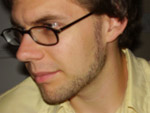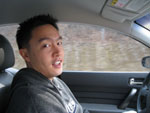Director |
 |
Roger LevyMy research focuses on theoretical and applied questions in the processing of natural language. Inherently, linguistic communication involves the resolution of uncertainty over a potentially unbounded set of possible signals and meanings. How can a fixed set of knowledge and resources be deployed to manage this uncertainty? To address these questions I use a combination of computational modelling and psycholinguistic experimentation. This work furthers our understanding of the cognitive underpinning of language processing, and helps us design models and algorithms that will allow machines to process human language. |
Graduate Students |
 |
Klinton BicknellMy research focuses mostly on two
questions about human sentence processing. (1) What are the sources of
information that are available to the human sentence processor and how quickly
are these information sources used? (2) How are these various sources
combined, and how is conflict between them resolved? To answer these
questions, I make use of a broad range of methodologies, including behavioral
paradigms, neuropsysiological recordings, and computational modeling. |
 |
Rebecca ColavinMy main area of interest is
computational phonology. Currently, I am interested in phonotactics, the
set of language specific rules that determine the acceptability of sound
sequences. In particular, I am interested in the nature of the phonotactic
grammar and the relationship between lexical frequency and gradient speaker
judgments. |
 |
Gabriel DoyleI'm intrigued by a trio of psycholinguistic questions: what information do speakers know about their language, how do they learn this information, and how do they use it? I investigate these questions with a trifecta of models, building mixed-effects regression models to uncover the factors that drive speaker choice, Bayesian models for artificial-language learning experiments, and topic models for anything I can find. |
 |
Albert ParkI am currently focusing on the problem of natural
language parsing using probabilistic methods. I am intrigued by the capacity that people
have to use language, and believe that to replicate these capabilities in machines
we will need to create models based on the way human brains process language. |
 |
Nathaniel SmithI am interested in how
people manage to deploy language — a fantastically complicated
system — in the real world — an even more complex
environment, and one with radically different structure. Recently,
I've been studying probabilistic models as a potential piece of the
mechanism linking these domains. |
Collaborators |
| Galen Andrew, Microsoft Research |
| Sarah Bunin
Benor, Hebrew Union College |
| Sarah
Creel, UCSD |
| Hal
Daumé III, Maryland |
| Charles Elkan, UC San Diego |
| Jeff Elman, UC San Diego |
| Evelina Fedorenko, MIT |
| Victor Ferreira, UC San Diego |
| Ted Gibson, MIT |
| Noah Goodman, Stanford |
| Tom Griffiths, UC Berkeley |
| Mary Hare, Bowling Green State University |
| T. Florian Jaeger, Rochester |
| Andy Kehler, UC San Diego |
| Frank Keller, University of Edinburgh |
| Marta Kutas, UC San Diego |
| Chris Manning, Stanford |
| Ken McRae, University of Western Ontario |
| Keith Rayner, UC San Diego |
| Florencia Reali, UC Berkeley |
| Hannah Rohde, Edinburgh |
| Tim Slattery,
University of South Alabama |
| Tom Wasow, Stanford |